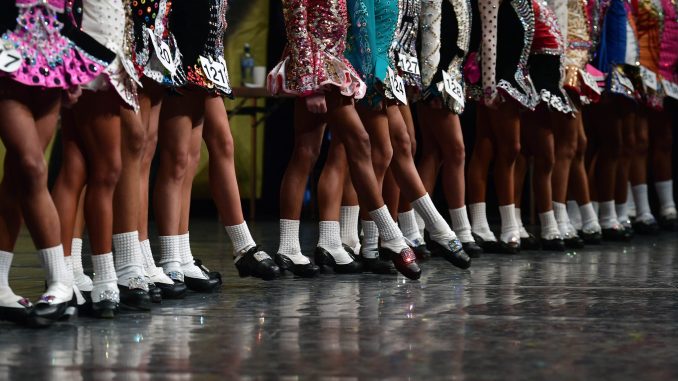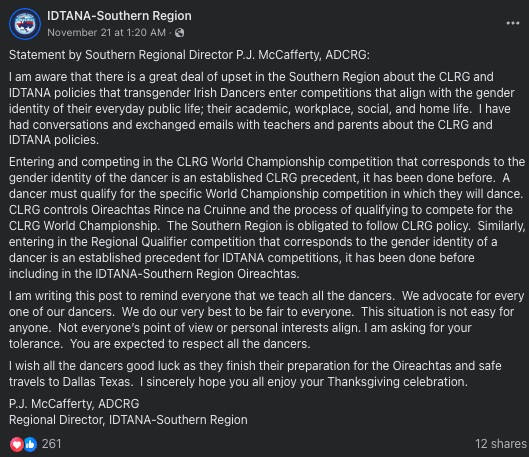
FIRST ON THE DAILY SIGNAL: A teenage boy who identifies as a girl is heading to the Irish Dancing World Championships after placing first in the U14 2023 Southern Region Oireachtas competitions. Parents of girls competing in Irish dance are frustrated and outraged, saying that they cannot understand why a boy with physical advantages is allowed to dance against their daughters.
“Oh, my gosh. It’s going to make me cry,” said one mother, whose daughter danced in the same competition as the trans-identifying boy in the Dallas, Texas event. “I never thought I was going to have to deal with this. And my heart breaks for my daughter and the other girls that are having to deal with this. They are too young to have to deal with topics that are going on in society, that are adult topics, that they don’t quite comprehend yet.”
“They just look at it as unfair,” she added emotionally. “And it’s really hard to explain to them what’s going on and why they have to accept it. That’s what society’s making them do. As a mom, I want to be an advocate for my daughter. But at the same time, I have to protect my family.”
The Daily Signal has chosen not to name or picture the boy who won the U14 dance competition since he is a minor. Dance results show that the child formerly competed as a boy and placed 11th in the world in the Coimisiún Le Rincí Gaelacha (CLRG) World Championships in April 2023.
The boy’s social media includes the preferred pronouns “she/her” and pictures of the child at Irish dancing competitions depict him wearing the typical dance attire for girls, including dresses, makeup, and wigs. Results show that the boy finished first out of 100 dancers in the early December girls’ U14 competition, making him both a world qualifier and a national qualifier.
He dances with the Inis Cairde School of Irish Dance, which did not respond to requests for comment, nor did his teacher. The boy’s mother did not respond to requests for comment via her purported social media accounts.
In a video reviewed by The Daily Signal of the boy winning the U14 girls competition on Sunday, girls in the background can be seen with jaws dropped, looking at one another when they realize that he has been declared the winner.
“My daughter was in absolute tears,” shared the mother whose daughter competed against the boy last weekend. Her daughter was unaware he was a boy until he received first place and word spread like wildfire throughout the competition, she said. “She was like, ‘This is so unfair.’ I totally agree.”
Message boards reviewed by The Daily Signal show that many within the Irish Dance community are up-in-arms about the event. Users purporting to be parents expressed outrage about a boy dancing in and winning a girls’ competition — then expressed more outrage when their posts were deleted by the Voy message board moderator (who also deleted a post by this journalist requesting parents reach out for this story).
A number of parents reached out to The Daily Signal to share their frustrations, requesting anonymity to protect their daughters’ privacy and dancing futures.
“Parents think it’s outrageous,” shared one dancer’s parent, who spoke anonymously to preserve family privacy. “They are absolutely outraged. It’s absolutely ridiculous, just like in any other sport, and we’re seeing it play out on the national stage in the congressional hearings this week.”
“The feeling is one of fundamental unfairness,” this parent added. “And then obviously the frustration and resentment that goes along with that.”
“It’s just not OK,” protested a mother whose daughter also danced at the Southern Region Oireachtas and is now heading to the World Championships. “It’s totally wrong. It’s unfair, especially in Irish dance. A lot of it is just about power and strength. Yes, there is the technique … but a lot of it also has to do with strength and power and the boys are stronger.”
Parents told The Daily Signal they do not understand when or how the leaders of the Irish dancing community made the decision to allow boys to compete as girls. But emails from the Southern Regional director shine some light on this process.
In an Oct. 30 email obtained by The Daily Signal, Southern Regional Director PJ McCafferty told Irish dance teachers that at the June 30, 2022 Annual Convention of the Irish Dance Teachers’ Association of North America (IDTANA), the members in attendance adopted an inclusivity statement.
That statement said that the IDTANA is committed to “a culture where every dancer, family, teacher, and volunteer feel safe, respected and valued through creating an environment that provides dancers, regardless of age, ability, ethnicity, gender, gender identity, income, race or sexual orientation, opportunities to learn and grow as dancers and people.”
McCafferty also revealed in this Oct. 30 email that he convened a meeting of the Southern Region Executive Board and proposed a motion allowing trans-identifying dancers to compete as the gender they aligned with: “At the Southern Region Qualifying Oireachtas, dancers may compete in the competition appropriate for the gender they identify as in their everyday life, without regard for their gender at birth.”
“The motion passed in a secret ballot,” he shared.
Then, in a Nov. 21 post, McCafferty publicly addressed concerns about the boy dancing in the girls’ competitions, acknowledging that there is “a great deal of upset” about the matter but emphasizing that “entering and competing in the CLRG [Coimisiún Le Rincí Gaelacha] World Championship competition that corresponds to the gender identity of the dancer is an established CLRG precedent.”
“It has been done before,” said the regional director, who did not respond to multiple requests for comment — nor did the Coimisiún Le Rincí Gaelacha (CLRG), the governing body for global competitive Irish step dancing (recently under fire for “feis-fixing” allegations that teachers were bestowing sexual favors on judges in exchange for their pupils’ advancements).
“I am writing this post to remind everyone that we teach all the dancers,” McCafferty continued. “We advocate for every one of our dancers. We do our very best to be fair to everyone. This situation is not easy for anyone. Not everyone’s point of view or personal interests align. I am asking for your tolerance. You are expected to respect all the dancers.”

He urged the dancing instructors to “be proactive and speak to dancers and parents in your class who are aggrieved by these policies,” telling the teachers to “explain that we are required to adhere to CLRG and IDTANA policies,” according to a Nov. 20 email obtained by The Daily Signal.
Many of the female dancers’ parents expressed fears that the Irish dance community would label them as transphobic or hateful if they spoke up for their daughters — and they fear that their daughters will suffer if they speak out. But the parents also stressed that they merely want fairness for their young dancers, who they do not think should compete against a boy.
“My husband could lose his job,” said the mother of the girl who danced in the same competition as the boy. “I could lose my job. I’m afraid my child might be chastised or, you know, not allowed to compete in other Irish dancing. This is what she loves. This is her passion.”
Rowena Ryan is a former Irish dance instructor and adjudicator who taught for over 20 years and whose daughter formerly competed as a dancer. Ryan noted in a phone interview with The Daily Signal that there are many members of the LGBTQ community within the Irish dance world and that she “100%” supports them, “as do the majority of the teachers and adjudicators within Irish dance.”
But that doesn’t change the fact that boys have physical advantages over girls in Irish dance, she said: “There’s just no getting around the physical differences between men and women.”
“When you’re judging competitions between girls and boys, things that you look for are different in a male dancer compared to a female dancer,” she said. “So I just don’t think it’s fair to have the two competing against another because they are judged on different criteria.”
“You can identify as a giraffe if that’s what you want to do,” the former judge added. “I believe firmly in live and let live. It’s when someone else’s decisions are then affecting a lot of other people that you then have to sit back and decide what needs to happen. And I’m sorry, but girls need to compete against girls and boys need to compete against boys.”
Maggie McKneely, a young woman who competed in the adult competition at the Southern Region Oireachtas last weekend, also reflected on the situation in a phone interview with The Daily Signal.
“Most sports, men and women tend to do the same basic activity, just at very different skill levels, but Irish dance is highly gendered,” explained McKneely, who works as a legislative strategist for the conservative organization, Concerned Women for America. “The two sexes wear different shoes, they wear different clothes, they actually have completely different dance styles. They’re really not interchangeable in any way.”
“If a boy decides to compete as a girl, he has to learn how to dance like a girl and wear girls’ dance shoes,” she continued. “So I think it’s really ridiculous. It’s not fair to the kids. It’s certainly not fair to the girls who have to compete against the boy. And it totally undermines what makes Irish dance what it is, the highly gendered aspect of it is a defining feature.”
What is next for those who dissent from the Irish dancing world’s apparent embrasure of gender ideology? Parents who spoke with The Daily Signal hope that their voices will help bodies like the CLRG to recognize that only girls should compete against girls. Some of these parents are preparing to take a public stand if their daughters are forced to compete against a boy.
They feel, as McKneely wrote in a Thursday blog post, that “the powers that be within Irish dance are more interested in being politically correct than preserving both the dignity of Irish dance and its dancers.”
Have an opinion about this article? To sound off, please email letters@DailySignal.com, and we’ll consider publishing your edited remarks in our regular “We Hear You” feature. Remember to include the URL or headline of the article plus your name and town and/or state.

